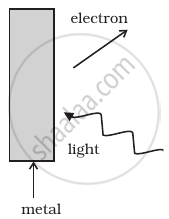Advertisements
Advertisements
Question
The work function of caesium metal is 2.14 eV. When light of frequency 6 × 1014 Hz is incident on the metal surface, photoemission of electrons occurs. What is the
(a) maximum kinetic energy of the emitted electrons,
(b) Stopping potential, and
(c) maximum speed of the emitted photoelectrons?
Solution
Work function of caesium metal, `phi_"o"` = 2.14 eV
Frequency of light, v = 6.0 × 1014 Hz
(a) The maximum kinetic energy is given by the photoelectric effect as:
`"K" = "hv" - phi_"o"`
Where,
h = Planck’s constant = 6.626 × 10−34 Js
∴ K = `(6.626 xx 10^34 xx 6 xx 10^14)/(1.6 xx 10^(-19)) - 2.14`
= 2.485 − 2.140
= 0.345 eV
Hence, the maximum kinetic energy of the emitted electrons is 0.345 eV.
(b) For stopping potential `"V"_"o"`, we can write the equation for kinetic energy as:
`"K" = "eV"_"o"`
∴ `"V"_"o" = "K"/"e"`
= `(0.345 xx 1.6 xx 10^(-19))/(1.6 xx 10^(-19))`
= 0.345 V
Hence, the stopping potential of the material is 0.345 V.
(c) Maximum speed of the emitted photoelectrons = v
Hence, the relation for kinetic energy can be written as:
`"K" = 1/2 "mv"^2`
Where,
m = Mass of an electron = 9.1 × 10−31 kg
`"v"^2 = (2"K")/"m"`
= `(2 xx 0.345 xx 1.6 xx 10^(-19))/(9.1 xx 10^(-31))`
= 0.1104 × 1012
∴ v = 3.323 × 105 m/s
= 332.3 km/s
Hence, the maximum speed of the emitted photoelectrons is 332.3 km/s.
APPEARS IN
RELATED QUESTIONS
Find the maximum frequency of X-rays produced by 30 kV electrons.
Find the (a) maximum frequency, and (b) minimum wavelength of X-rays produced by 30 kV electrons.
How does one explain the emission of electrons from a photosensitive surface with the help of Einstein's photoelectric equation?
An isolated metal sphere is heated to a high temperature. Will it become positively charged due to thermionic emission?
A diode value is connected to a battery and a load resistance. The filament is heated, so that a constant current is obtained in the circuit. As the cathode continuously emits electrons, does it become more and more positively charged?
Why does thermionic emission not take place in non-conductors?
Define the term "Threshold frequency", in the context of photoelectric emission.
The wave associated with a moving particle of mass 3 × 10–6 g has the same wavelength as an electron moving with a velocity 6 × 106 ms–1. The velocity of the particle is
If a light of wavelength 330 nm is incident on a metal with work function 3.55 eV, the electrons are emitted. Then the wavelength of the wave associated with the emitted electron is (Take h = 6.6 × 10–34 Js)
Define the work function of a metal. Give its unit.
What do you mean by electron emission? Explain briefly various methods of electron emission.
A 150 W lamp emits light of the mean wavelength of 5500 Å. If the efficiency is 12%, find out the number of photons emitted by the lamp in one second.
In which case is electron emission from a metal not known?
Consider Figure for photoemission.

How would you reconcile with momentum conservation? Note light (photons) have momentum in a different direction than the emitted electrons.
The work function of a metal is 2.31 eV. Photoelectric emission occurs when the light of frequency 6.4 × 1014 Hz is incident on the metal surface. Calculate
- the energy of the incident radiation,
- the maximum kinetic energy of the emitted electron and
- the stopping potential of the surface.
